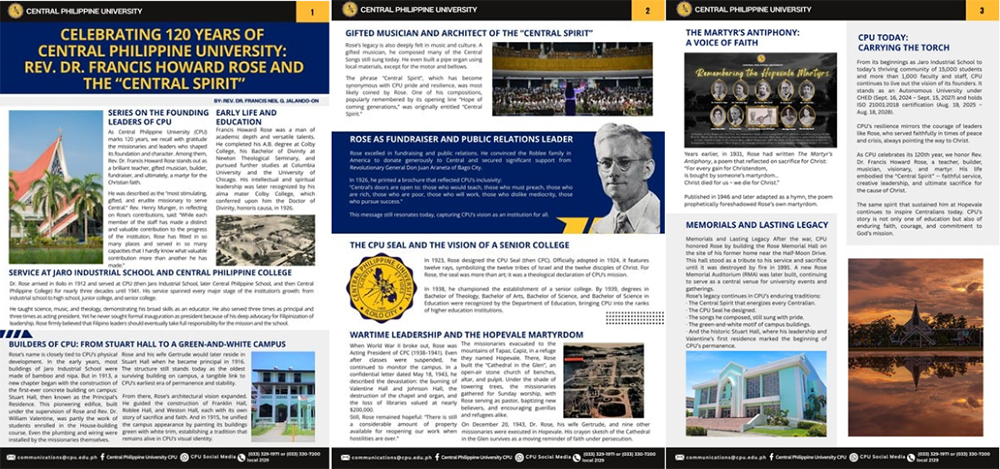By Rev. Dr. Francis Neil G. Jalando-on

Central Philippine University (CPU) is turning 120 years old this coming October 1, 2025. To God be the greatest glory!
Series on the Founding Leaders of CPU
As Central Philippine University (CPU) marks 120 years on October 1, 2025, we recall with gratitude the missionaries and leaders who shaped its foundation and character. Among them, Rev. Dr. Francis Howard Rose stands out as a brilliant teacher, gifted musician, builder, fundraiser, and ultimately, a martyr for the Christian faith.
He was described as the “most stimulating, gifted, and erudite missionary to serve Central.” Rev. Henry Munger, in reflecting on Rose’s contributions, said: “While each member of the staff has made a distinct and valuable contribution to the progress of the institution, Rose has fitted in so many places and served in so many capacities that I hardly know what valuable contribution more than another he has made.”
Early Life and Education
Francis Howard Rose was a man of academic depth and versatile talents. He completed his A.B. degree at Colby College, his Bachelor of Divinity at Newton Theological Seminary, and pursued further studies at Columbia University and the University of Chicago. His intellectual and spiritual leadership was later recognized by his alma mater Colby College, which conferred upon him the Doctor of Divinity, honoris causa, in 1926.
Service at Jaro Industrial School and Central Philippine College
Dr. Rose arrived in Iloilo in 1912 and served at CPU (then Jaro Industrial School, later Central Philippine School, and then Central Philippine College) for nearly three decades until 1941. His service spanned every major stage of the institution’s growth: from industrial school to high school, junior college, and senior college.
He taught science, music, and theology, demonstrating his broad skills as an educator. He also served three times as principal and three times as acting president. Yet he never sought formal inauguration as president because of his deep advocacy for Filipinization of leadership. Rose firmly believed that Filipino leaders should eventually take full responsibility for the mission and the school.
Builders of CPU: From Stuart Hall to a Green-and-White Campus
Rose’s name is closely tied to CPU’s physical development. In the early years, most buildings of Jaro Industrial School were made of bamboo and nipa. But in 1913, a new chapter began with the construction of the first-ever concrete building on campus: Stuart Hall, then known as the Principal’s Residence. This pioneering edifice, built under the supervision of Rose and Rev. Dr. William Valentine, was partly the work of students enrolled in the House-building course. Even the plumbing and wiring were installed by the missionaries themselves.
Rose and his wife Gertrude would later reside in Stuart Hall when he became principal in 1916. The structure still stands today as the oldest surviving building on campus, a tangible link to CPU’s earliest era of permanence and stability.
From there, Rose’s architectural vision expanded. He guided the construction of Franklin Hall, Roblee Hall, and Weston Hall, each with its own story of sacrifice and faith. And in 1915, he unified the campus appearance by painting its buildings green with white trim, establishing a tradition that remains alive in CPU’s visual identity.
Gifted Musician and Architect of the “Central Spirit”
Rose’s legacy is also deeply felt in music and culture. A gifted musician, he composed many of the Central Songs still sung today. He even built a pipe organ using local materials, except for the motor and bellows.
The phrase “Central Spirit”, which has become synonymous with CPU pride and resilience, was most likely coined by Rose. One of his compositions, popularly remembered by its opening line “Hope of coming generations,” was originally entitled “Central Spirit.”
Rose as Fundraiser and Public Relations Leader
Rose excelled in fundraising and public relations. He convinced the Roblee family in America to donate generously to Central and secured significant support from Revolutionary General Don Juan Araneta of Bago City.
In 1926, he printed a brochure that reflected CPU’s inclusivity:
“Central’s doors are open to: those who would teach, those who must preach, those who are rich, those who are poor, those who will work, those who dislike mediocrity, those who pursue success.”
This message still resonates today, capturing CPU’s vision as an institution for all.
The CPU Seal and the Vision of a Senior College
In 1923, Rose designed the CPU Seal (then CPC). Officially adopted in 1924, it features twelve rays, symbolizing the twelve tribes of Israel and the twelve disciples of Christ. For Rose, the seal was more than art; it was a theological declaration of CPU’s mission.
In 1938, he championed the establishment of a senior college. By 1939, degrees in Bachelor of Theology, Bachelor of Arts, Bachelor of Science, and Bachelor of Science in Education were recognized by the Department of Education, bringing CPU into the ranks of higher education institutions.
Wartime Leadership and the Hopevale Martyrdom
When World War II broke out, Rose was Acting President of CPC (1938–1941). Even after classes were suspended, he continued to monitor the campus. In a confidential letter dated May 18, 1943, he described the devastation: the burning of Valentine Hall and Johnson Hall, the destruction of the chapel and organ, and the loss of libraries valued at nearly $200,000.
Still, Rose remained hopeful: “There is still a considerable amount of property available for reopening our work when hostilities are over.”
The missionaries evacuated to the mountains of Tapaz, Capiz, in a refuge they named Hopevale. There, Rose built the “Cathedral in the Glen”, an open-air stone church of benches, altar, and pulpit. Under the shade of towering trees, the missionaries gathered for Sunday worship, with Rose serving as pastor, baptizing new believers, and encouraging guerillas and refugees alike.
On December 20, 1943, Dr. Rose, his wife Gertrude, and nine other missionaries were executed in Hopevale. His crayon sketch of the Cathedral in the Glen survives as a moving reminder of faith under persecution.
The Martyr’s Antiphony: A Voice of Faith
Years earlier, in 1931, Rose had written The Martyr’s Antiphony, a poem that reflected on sacrifice for Christ:
“For every gain for Christendom,
Is bought by someone’s martyrdom…
Christ died for us – we die for Christ.”
Published in 1946 and later adapted as a hymn, the poem prophetically foreshadowed Rose’s own martyrdom.
Memorials and Lasting Legacy
After the war, CPU honored Rose by building the Rose Memorial Hall on the site of his former home near the Half-Moon Drive. This hall stands as a tribute to his service and sacrifice.
Rose’s legacy continues in CPU’s enduring traditions:
- The Central Spirit that energizes every Centralian.
- The CPU Seal he designed.
- The songs he composed, still sung with pride.
- The green-and-white motif of campus buildings.
- And the historic Stuart Hall, where his leadership and Valentine’s first residence marked the beginning of CPU’s permanence.
CPU Today: Carrying the Torch
From its beginnings as Jaro Industrial School to today’s thriving community of 15,000 students and more than 1,000 faculty and staff, CPU continues to live out the vision of its founders. It stands as an Autonomous University under CHED (Sept. 16, 2024 – Sept. 15, 2027) and holds ISO 21001:2018 certification (Aug. 19, 2025 – Aug. 18, 2028).
CPU’s resilience mirrors the courage of leaders like Rose, who served faithfully in times of peace and crisis, always pointing the way to Christ.
As CPU celebrates its 120th year, we honor Rev. Dr. Francis Howard Rose, a teacher, builder, musician, visionary, and martyr. His life embodied the “Central Spirit” — faithful service, creative leadership, and ultimate sacrifice for the cause of Christ.
The same spirit that sustained him at Hopevale continues to inspire Centralians today. CPU’s story is not only one of education but also of enduring faith, courage, and commitment to God’s mission.
References
Bunda, N. D. (1999). A mission history of the Philippine Baptist churches, 1898–1998: From a Philippine perspective. Verlag an der Lottbek im Besitz des Verlags Mainz.
Jalando-on, F. N. G. (2003). A history of Philippine Baptist pastors, 1898–2002. Iloilo City.
Lund, E. (1900). Report to the Baptist Missionary Union. (As cited in Munger, 1938).
Munger, H. W. (1938). Baptists in the Philippines. The Chronicle, 1(4), p. 171.
Nelson, L. A., & Herradura, E. S. (1981). Scientia et Fides The Story of Central Philippine University. Iloilo City.
Valentine, W. O. (1916). Moral and religious values of industrial education (Master’s thesis). University of Chicago.
Centralite. (2002). [Special issue], p. 32.
Report of Dr. Pulido to CPBC Assembly held at CPU, May 4, 1978. (As cited in Nelson & Herradura, 1981, p. 370).
Barbour, T. (1904, September 27). Letter to Rev. William Valentine.
Philippine Baptist Mission Conference. (1904, June 13). Founding record.
